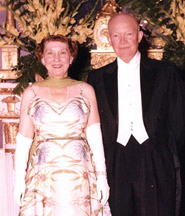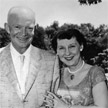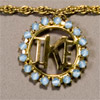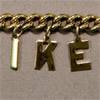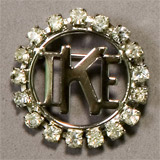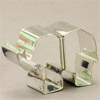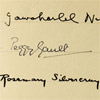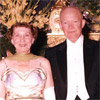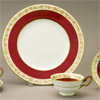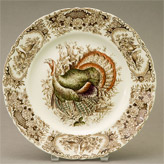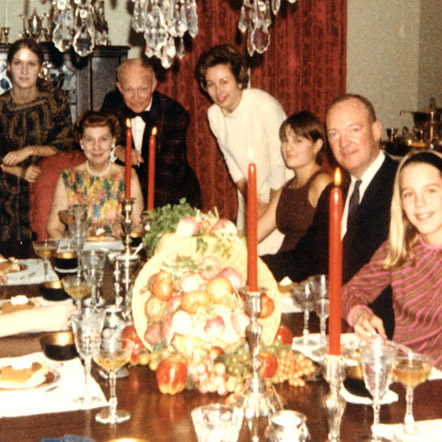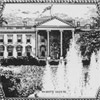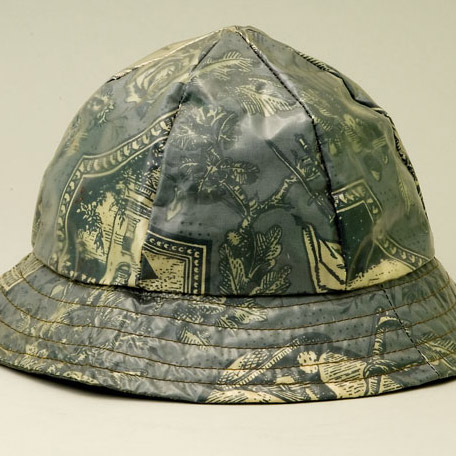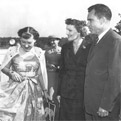|
- Emily Weaton Porter (Museum Educator, Museum Management Program, National Park Service)
- Grades 7-8
- 5 lessons
[Back to top]
|
- Eisenhower National Historic Site, Gettysburg, PA
-
This lesson unit explores post-World War II (WWII) American culture by focusing on Mamie Eisenhower, "America's Most Admired Woman of the mid-20th Century." Interactive activities will engage students with museum objects and primary source material from the Eisenhower National Historic Site, and the Eisenhower Presidential Library (Abilene, KS) to provide insight into Mamie Eisenhower's personality, achievements, and cultural significance. Students will compare their own experiences and values with those of mid-20th century Americans.
-
- How does Mamie Eisenhower, the First Lady from 1953 - 1961, represent the American experience (particularly the experience of the American woman) in the mid-20th century and how do these experiences resonate with contemporary Americana?
[Back to top]
|
| MUSEUM OBJECT [photos of objects in the Carl Sandburg Home NHS museum collections] |
SIMILAR OBJECTS [local items similar to museum objects] & OTHER MATERIALS |
Length of time |
|
60 minutes |
|
- Modern election paraphernalia
- Charm or ID bracelets
:
Appropriate craft material for creating political paraphernalia
|
60 minutes |
|
:
|
|
|
- Item from a dining service
- Kitschy decorative element from teacher’s Thanksgiving tradition
:
|
60 minutes |
|
- Student-supplied visual representations of their own Thanksgiving traditions
- Paper circles/rectangles to make “Thanksgiving tables” for display Poster board squares for students’ “textbook descriptions”
|
|
|
- Toile fabric swatch
- Modern rain hat
- Modern hats or baseball caps with a meaningful pattern/logo
- Muslin/poster board/construction paper
- Markers and/or paint
- Poster board squares for “captions
|
60 minutes |
[Back to top]
|
When taught as a unit, these five lessons address the following relevant curriculum standards:
- Literacy in History/Social Studies, Grades 6-8 (RH.6-8): 1, 2, 6, 7
- Speaking and Listening, Grade 7 (SL.7) and Grade 8 (SL.8): 1a-d, 2, 3, 4, 5, 6
- Anchor Standards for Writing Grades K-12 (W): 1, 2, 3, 4, 7, 9
- Writing, Grade 7 (W.7) and Grade 8 (W.8): 2a-f, 3b, 3d, 4, 7, 9b,
[Back to top]
|
Students will be able to:
- Analyze and interpret museum objects, historic photographs, and documents.
- Identify and articulate underlying messages of commemorative materials.
- Create a personal commemorative item.
- Use objects to deduce cultural attitudes.
- Analyze changes in gender roles over time.
- Create a political strategy and write a campaign memo.
- Evaluate the First Lady’s role in supporting U.S. diplomatic relationships.
- Explain the function and execution of a White House State dinner.
- Craft and deliver an argument during a debate.
- Compare and contrast mid-20th century and contemporary American attitudes towards home and family.
- Analyze foodways as expressions of cultural heritage.
- Deduce dominant cultural trends from individual personal traditions.
- Compare and contrast the use and meaning of artistic designs and logos in present day and mid-20th century culture.
- Create self-representative visual motifs with explanatory captions.
[Back to top] |
See PDF copy of “Mamie Eisenhower in Perspective” by Carol A. Hegeman from Mamie Eisenhower, Wife, Mother, First Lady: Her Impact and Influence on her Time. Gettysburg, PA: The Eisenhower National Historic Site, 1996.
|
Baby Boom: The spike in American births that occurred after WWII and correlated with prosperous, postwar living conditions.
Blair House: An historic home near the White House where visiting heads of state and foreign dignitaries may stay during visits to the U.S.
Cold War: The non-combatant nuclear standoff between the U.S. and the Soviet Union. It lasted over four decades and was predicated on the two global powers each having nuclear arsenals and the potential to use them.
Duck and Cover: The protective method taught to schoolchildren in the 1950s in the event of a nuclear attack. Should an atomic bomb fall, students were to crawl under their desks to take cover. (View a video teaching students how to Duck and Cover.)
Exhibit caption: A short label (50-100 words) that describes an item (object, specimen, or photograph) on exhibit in a museum. Exhibit captions may be used to orient visitors to a gallery or room. The caption includes information about the creator, material, measurements, etc., as well as contextual information.
Material Culture: The relationship between physical objects and the society and individual people that produced or owned these objects. The information about people and societies that can be learned by studying specific physical objects related to them.
McCarthyism: The sentiment driving the anti-communist witch-hunts in 1950s America. Senator Joseph McCarthy tried American citizens for suspected sympathy with Communist governments, supposedly to protect America from Communist spies. In reality, he used these trials to punish his political enemies and create a culture of fear among Americans.
The Middle Way: An early form of moderate Republicanism that guided President Eisenhower’s domestic policies. He favored limiting governmental involvement, yet advocated intervention when he believed it strengthened the rights of the individual. He continued the New Deal and Fair Deal domestic programs, ordered the desegregation of the military, and authorized federal troops to assist in the desegregation of schools in Arkansas.
Toile: A pattern typically used on fabric, in which a complex scene is represented in a single color and repeated on a white backing. Although toile usually depicts peaceful country scenes, it can use any repeating design. Originating in 18th century Europe, toile was popular during the American colonial period and has seen periodic resurgences in popularity.
[Back to top]
|
|
|
Before all lessons:
- Make class set copies of photographs listed in Column 1 of Table C.
- Secure and bring to class all materials listed in Column 2 of Table C.
- Assign students to small groups for each lesson (or to the same group through the week).
Lesson #1: Who is Mamie?
Lesson #2: The Elephant in the Room
Lesson #3: Guess Who’s Coming to Dinner
Lesson #4 (Part 2): Home Is Where the Heart Is
- Prepare materials for the bulletin board exhibit of traditions.
- “Thanksgiving tables”
- Poster board squares for captions
Lesson #5: Making a Fashion Statement
- Find swatch of modern toile fabric and bring to class.
- Bring in a modern hat with logo/message.
- Prepare “pattern-making” supplies (see Table C).
- Bring masking tape/clothespins to hook fabric “quilt” together.
[Back to top] |
Lesson 1: Who is Mamie?
This lesson introduces students to object-based inquiry using museum objects to establish familiarity with Mamie Eisenhower and 1950s culture and to explore:
- how commemorative material creates a story about the person/period it represents, and
- how collected objects tell an important story about the collector.
Talking Points
- Mamie Eisenhower was:
- The First Lady of the United States from 1953 - 1961. A beloved public figure, she was idealized as the perfect symbol of 1950s American femininity.
- A military wife for over thirty years, who supported Eisenhower’s career by serving as both the hostess to important foreign diplomats and the leader of the wives and families in his unit. She is widely quoted as saying “I have but one career, and his name is Ike.”
- Beloved by the American people for her down-to-earth nature, typified by her habit of collecting and displaying kitschy objects.
- During the 1952 campaign, Ike often referred to his reliance upon Mamie’s input and opinions in order to connect with female voters and associate the work of managing a 1950s home to the work of a president.
Procedures
- Discuss what material culture (and commemorative objects) can reveal about the society that produced the object and the people who collected it.
- Assign each student group to one of the objects (plate, picture, interpretive caption appearing on webpage) and provide printout to each student.
- Distribute “How to Read an Object,” “How to Read a Photograph” and “How to Read a Caption” worksheets.
- Groups complete the appropriate worksheet for their object and develop a list of conclusions that they can draw about Mamie or the 1950s from it within 10-15 minutes.
- Each group will present its list of conclusions before beginning the Student Activity.
Student Activity: “Analyzing the Collector”
Explore material culture by creating commemorative plates.
- Students use their photographs to create a commemorative plate for the person, period, or event of their choice and write a one paragraph summary of what they think the plate says about them (the creators/collectors).
- Students exchange their plates with a partner who will write a one-paragraph summary of what the plate s/he has received tells him/her about the creator/collector.
Lesson 2: The Elephant in the Room
This lesson uses political paraphernalia from Eisenhower’s 1952 campaign to explore the new prominence that women voters played in the election. It also introduces students to the relationships between 1) Mamie and Ike and 2) Mamie and the public.
Talking Points
- The 1952 presidential campaign focused on “Family Values,” a concept influenced by the Cold War and women returning to traditional roles in the home after working during WWII.
- Some political wives had campaigned for the presidency with their husbands, but the 1952 campaign entrenched the role of the First Lady as “campaign wife.” Mamie’s appearance as the adoring wife and mother made her the perfect crystallization of the “family values” message of the Eisenhower campaign.
- Mamie was particularly popular with women in the 1950s. They perceived her as one of their own: a housewife, a mother, a garden-club member.
Procedures
- Students will examine examples of modern political paraphernalia and identify different cultural values or themes from them.
- Students will examine the contemporary charm or ID bracelets as material culture artifacts and make hypotheses about what the charms/ID inscriptions signify for the wearer.
- Distribute images of the “Ike” charm bracelets, brooch, and cookie cutter. Compare the Ike charm bracelet to the modern bracelets.
- What did the makers of these objects think was important to women in the 1950s?
- What would you use to recruit girls’ votes if you were running for class president? What would you use to recruit boys’ votes?
- Distribute Appendix 2: The Eisenhowers and the 1950s. Give student groups 10 minutes to read the text and identify:
- three dominant cultural trends that influenced 1950s political paraphernalia, and
- at least one reason that modern women would or would not respond to these objects.
- Groups share their findings.
Student Activity: “Ike, Ike, He’s Our Man”
Create political paraphernalia that might appeal to 1950s women.
- Each student creates a new political object (slogan, object, poster, etc.) to attract votes from 1950s women.
- Students write a memo from the perspective of an Eisenhower campaign staffer to his superior explaining why this object/design would be effective in the 1952 presidential campaign.
Lesson 3: Guess Who’s Coming to Dinner?
This lesson explores 1) Mamie’s role as First Lady and “national hostess” and 2) the importance of ceremonial display in the shaping of international relationships.
Talking Points
- Mamie Eisenhower was praised by contemporary media and the public for White House entertaining. She was known for coordinating the menu, decorations, seating chart, and entertainment to suit the tastes and comfort of the guests of honor.
- The Eisenhower administration welcomed 37 heads of state, more than any previous administration. As president during the Cold War, Ike preferred in-person meetings with other heads of state. Additionally, airplanes made international travel more prevalent.
- Thirty influential dignitaries also visited during the Eisenhower administration. The Eisenhowers had established relationships with many of them during Ike’s tenure as the NATO Supreme Allied Commander, Europe.
- The Eisenhowers often hosted diplomatic visitors at their home in Gettysburg and ate dinner on the porch.
Procedures
- Distribute photograph of Ike and Mamie in the Blue Room and selected images from other White House State Dinners (from Time photo essay). Compare White House State dinners across historical periods.
- What do State Dinners accomplish? Why are they important?
- Distribute photograph of the guestbook page listing visitors to the Gettysburg house. Display a physical guestbook; encourage students to examine and compare.
- Why might Mamie have kept a guestbook? How might a guestbook be useful to students today? To their parents or other adults?
- Display photographs of the Gettysburg porch and the dining room. Which would students prefer to eat in and why?
- What can they infer about Mamie’s role as the First Lady from the way that she hosted these guests at her Gettysburg home?
- What can students infer about gender roles in the 1950s from this dynamic?
Student Activity: “White Tie vs. White Paper Napkins”
Hold a class debate about the Eisenhowers’ approach to receiving foreign dignitaries.
- One group argues for hosting important visitors informally on the Eisenhowers’ porch and one group argues for hosting state dinners for important visitors.
- Students should use the primary source material from Appendix 3: Nikita Khrushchev Visits the Eisenhower White House: 1959, to compose an argument that addresses the following:
- What could be accomplished in one setting and not the other?
- What external factors might contribute to one location being more successful?
- What cultural and historical factors might have influenced the Eisenhowers’ choice of location?
Lesson 4: Home is Where the Heart Is
This lesson spans two class periods and explores the importance of family and home to mid-20th century America, using the motif of Thanksgiving dinner.
Lesson 4, Part 1: Home is Where the Heart Is
Talking Points
- The Eisenhowers’ first son Doud Dwight died at three years old of scarlet fever. One year later, their son John was born.
- Mamie and Ike doted upon their grandchildren David, Anne, Susan, and Mary Jean. The children were a frequent presence at the White House and at Gettysburg.
- Mamie Eisenhower celebrated every holiday and anniversary to its fullest, often with unique family traditions.
- Mamie and Ike loved hosting big parties and celebrations at their Gettysburg home. They were the first presidential couple to hold a party for all White House staff.
Procedures
- Distribute copies of Thanksgiving photo and “How to Read a Photograph” chart to groups.
- Groups will focus on “reading” the people within the image.
- Begin the Student Activity “Mamie Eisenhower Likes Your Photo.”
- Distribute images of dinner service and turkey dinner plate and display contemporary objects.
- Connect modern plates and dining items to Mamie’s dinner service and turkey plate.
- How do the physical plates, or Mamie’s dinner service and the turkey plate remind students of objects that their families bring out on special occasions?
- What kind of serving dishes do they use in your home? Do they use different ones on special occasions?
Student Activity: “Mamie Eisenhower Likes Your Photo”
Role-play the dialogue that might result after the Eisenhowers’ Thanksgiving Feast photo is posted to Facebook or other social media service.
- Each student selects an individual from the Thanksgiving photo and writes a 2-3 sentence first-person monologue about how they feel in this photo.
- Students work together to create the social media dialogue between the characters (i.e. select which person “posts” the photo, how s/he might caption it, who would comment on the photo, what they would say, and what others might say in response).
- Groups perform their dialogue (and the individual monologues that inspired their characters’ responses) for the class.
for Lesson 4b: Students will select a tradition/food/object from their own Thanksgiving to investigate and represent in a collage or drawing. Students will also prepare a two-page report describing the tradition/food/object, how it started, and what it means to them in the context of Thanksgiving and/or their family.
- Students must engage in oral history research to determine how the tradition originated, how it has changed over time, what it means to other family members, etc.
Lesson 4, Part 2: Home is Where the Heart Is
Procedures
- Collect students’ reports.
- At the end of class, collect each group’s paragraph and each student’s visual representation.
- Hang each group’s paragraph in the center of a “Thanksgiving table” on a wall display.
- Hang group members’ collages/drawings around their group’s “table.”
Student Activity: “21st Century Thanksgiving”
Consider common elements emerging from students’ individual traditions.
- Students present to their groups the collage/drawing of their tradition and explain its context and history.
- Groups list common themes they find, as well as elements that make each tradition unique.
- Each group uses its list to consider what makes a “modern” Thanksgiving, then write a one-paragraph description about early 21st century Thanksgivings that might appear in a history book for students 50 years in the future.
Lesson 5: Making a “Fashion Statement”
Students will use their knowledge of the Eisenhowers (their relationship, feelings about family, history as a military couple, etc.) to interpret the pattern of the Eisenhower Toile.
Talking Points
- The Eisenhower Toile was designed for Dwight Eisenhower by Elisabeth Draper, the interior designer who decorated the Gettysburg home.
- Mamie had a dress, raincoat, and rain-hat made of the fabric. It was made into drapes for the Gettysburg home, used to decorate the Eisenhower bedroom of the Blair House, and made commercially available to the public.
- Mamie was an American fashion icon. She was known for wearing nipped waists, full skirts, hats, gloves, fur coats, charm bracelets, and her signature hairstyle. The pink dress she wore to the 1953 Inauguration created a nationwide mania for “Mamie Pink.”
- Mamie on the Eisenhowers as a military family: “…[We] are service people and anything that belonged to Uncle Sam…was untouchable as far as we were concerned. But still we want everyone to know that we’d been affiliated with the service for many, many, many years and anything that has to do with the government is very precious to us.”
Procedures
- Display modern hat with logo or pattern.
- What messages does this hat send about the person wearing it?
- What pieces of clothing do you own that expresses something important about you?
- Display picture of Ike and Mamie with the Nixons. Students will analyze Mamie’s appearance and interaction with others in this picture.
- What do you notice about Mamie’s appearance (her dress, her style, her demeanor)?
- How do the other subjects in the photo interact with her?
- How do these assumptions align with our knowledge of Mamie as a First Lady?
- Distribute image of toile pattern. Students will identify pattern elements and describe why they think those images were included. Students will consider why Americans in the 1950s might have bought this fabric for themselves.
Student Activity: “Pattern Play”
Design a personal toile pattern.
- The pattern should include at least four design elements that are significant to the student in some way.
- Students write an exhibit caption for their design that includes an explanation of each design element.
- Teacher makes a “quilt” of the student patterns, with captions attached, for classroom display.
|
- Active Participation in small group for all Student Activities
- Commemorative plate, paragraph, and partner paragraph (Lesson 1).
- Campaign object and memo (Lesson 2).
- Participation in group debate (Lesson 3).
- Thanksgiving tradition visuals and reports (Lesson 4).
- Toile pattern and exhibit caption (Lesson 5).
- Final Exhibit, if applicable. (see Culminating Activity in “Extension Activities”)
[Back to top]
|
Culminating Activity: Develop a Mamie Eisenhower Exhibit
- Develop “Mamie exhibit” themes based on class interest throughout the lesson unit (i.e. Mamie and fashion, Mamie as America’s hostess, the 1950s home, etc.)
- Small groups will select an exhibit theme and research 5-10 objects to include.
- Objects can be sourced from anywhere, including the ENHS online exhibit.
- Students should print images if they do not have physical objects.
- Each group will create 1) a caption for each object, 2) a brochure to provide visitors with context, and 3) a press release inviting other classes to view the exhibit.
Lesson 2: The Elephant in the Room
- Students will select a local referendum item and design a piece of political propaganda to engage voters from a particular group in support of their cause. Students will write a one-page report about why they chose that audience and why this object would motivate that group.
- Assign students a campaign year/era. Students will select a single voting audience group and will research how their campaign addressed that audience. Students will create a new piece of political paraphernalia that fits the cultural context of that campaign. Students will present their object to the class, along with a description of:
- the cultural values of their campaign era and
- how they would recommend that their campaign deploy this object most effectively.
Lesson 3: Guess Who’s Coming to Dinner
- Students will plan a modern presidential dinner for a foreign dignitary: style, guest list, food, entertainment, decoration, etc. (This can be done individually or as a class, with each student group researching a single part of the event.)
- Students will write a newspaper article describing either the state dinner that Mamie held at the White House to honor Nikita Khrushchev or Khrushchev’s visit to the Gettysburg farm. Students will determine what they should report (based on their research about the event) and how they think the reading public would interpret this event. See the “Thaw in the Cold War: Eisenhower and Khrushchev at Gettysburg” lesson plan for additional primary source material.
Lesson 4: Home is Where the Heart Is
- Students will compare 1967 signifiers of Thanksgiving with modern signifiers of Thanksgiving.
- The class will create a list of elements that signify “Thanksgiving” in the Eisenhowers’ Thanksgiving Feast photo.
- Beside this list, students will create a list of meaningful traditions/foods/objects from their contemporary celebrations. Each student will provide a new detail.
- Circle signifiers that carry between the eras (e.g. turkey, fancy dress, centerpieces).
- Each student will bring in a recipe that means “home” or “Thanksgiving” to him/her to create a class cookbook. Students could also make the dishes and bring them in to have a class “Thanksgiving.”
- Create a class time capsule with images of objects that students select to represent “home” or “family.” Each student should prepare a two-minute presentation describing his/her object, its importance, and the cultural contexts that make it so important.
Lesson 5: Making a Fashion Statement
- Discuss other cultures that use patterns or design to create a sense of history or identify someone as part of a community (Scottish plaids, Kente cloth, religious garments, sports paraphernalia, etc.). Students will select a type of representational fabric and write a two-page report about how it evolved, what type of community or value it signifies, and how it does so. They will include an object image and a 100-word exhibit caption
- Students will select a President or First Lady to research and will create a toile for them. Students will create exhibit captions that detail the significance of each design element.
|
- Boyle, Nancy. “Closing in on Close Reading.” Educational Leadership 70 (4). Dec 2012/Jan 2013.
- Eisenhower, Mamie Doud. Former First Lady, Gettysburg, Pennsylvania. Interview with Edwin C. Bearss, 15 August 1973.
- Eisenhower National Historic Site virtual museum exhibit. http://www.nps.gov/museum/exhibits/eise/
- Hegeman, Carol A. “Mamie Eisenhower in Perspective.” Mamie Eisenhower, Wife, Mother, First Lady: Her Impact and Influence on her Time. Gettysburg, PA: The Eisenhower National Historic Site, 1996.
- Hegeman, Carol A. “Thaw in the Cold War: Eisenhower and Khrushchev at Gettysburg.” National Park Service, Teaching with Historic Places. http://www.nps.gov/nr/twhp/wwwlps/lessons/29ike/29ike.htm
- Holt, Marilyn Irvin. Mamie Doud Eisenhower: The General’s First Lady. Lawrence, Kansas: University of Kansas, 2007.
- Mamie Eisenhower, Wife, Mother, First Lady: Her Impact and Influence on her Time. Gettysburg, PA: Eisenhower National Historic Site, 1996.
[Back to top]
|
The site visit includes a visit to the:
- Eisenhower National Historic Site or a similar site, such as the home of a local historically significant woman. Contact the site before your visit to arrange a facilitator or supplementary materials to enhance your visit.
- Eisenhower National Historic Site virtual museum exhibit.
Pre-visit:
Before the visit, students will visit the institution’s website for an overview and should come up with 2-3 questions to guide the visit. Teacher should work with park interpretive and museum staff to arrange the visit with challenging activities.
Site visit:
At the site, have students select and analyze at least two objects that draw upon one of the themes discussed during the “I Like Mamie!” curriculum. Provide students with packets containing two “How to Read an Object” sheets and two blank sheets for sketching. Encourage students to record only a limited section of the object to focus on the details of the object.
[Back to top]
|
|

